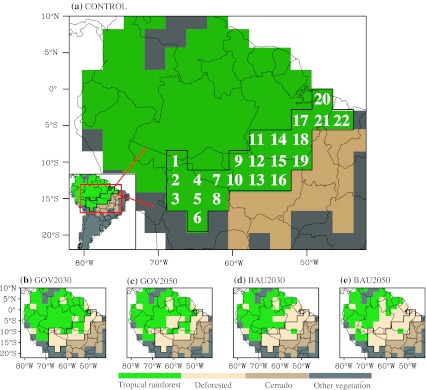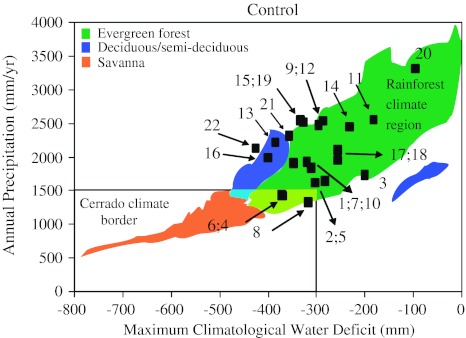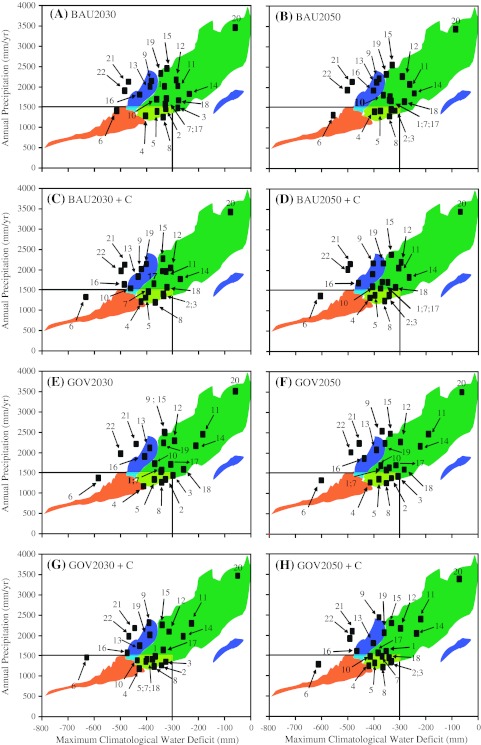Introduction
Despite widespread deforestation the forests of Amazonia still cover more than 5 million km2 and may host up to a quarter of the world’s terrestrial species (Dirzo and Raven 2003)—many of which are still undocumented. Conservation of these forests is important, not just for the biodiversity they contain, but also for the vital ecosystem services they provide. Historically, the greatest threat to Amazonia has been conversion to agriculture, initially through small-scale farming and, more recently, also through well-capitalized organizations producing agricultural and forestry products for global markets (Rudel et al. 2009). The attention of scientists and conservationists has recently shifted toward another factor that could radically alter the distribution, ecology, and value of the forest—climate change.
Climatologists predict that changes in atmospheric composition in the twenty-first century will cause Amazonia to experience an increase in temperatures of around 3°C and a reduction in precipitation of about 20% (IPCC 2007). In addition to well-documented changes in atmosphere chemistry, climate change in Amazonia may also be caused by the impacts of deforestation on vegetation–atmosphere interactions. These processes are not mutually exclusive, and both could act together to induce a more rapid shift in the system (Costa and Foley 2000).
Changes in the local climate—either caused by rising greenhouse gases or by local deforestation—may cause some parts of the Amazon rainforest to cross an ecological tipping point during this century (Cox et al. 2000; Lenton et al. 2008; Nobre and Borma 2009). Here, ‘tipping point’ refers to a critical threshold at which a relatively small perturbation can qualitatively alter the state or development of a system (Lenton et al.2008). In Amazonia, scientists have suggested that the tipping point is represented by some threshold in the area of the rainforest that, if crossed, would lead to a reduction of the rainfall and to an extension of the dry season, causing further reduction of the rainforest and shifting the system into a new and drier equilibrium. Such radical restructuring and re-sorting of the forest community is supported by evidence from paleoecology and ecophysiology. Mayle et al.’s (2004) review of paleovegetation and paleoclimate datasets revealed that a period of reduced precipitation 8,000–3,600 years ago resulted in widespread, frequent fires in southern Amazonia leading to “the competitive replacement of lowland evergreen rainforest taxa by drought-fire-tolerant semi-deciduous dry forest taxa and Cerrado savannas” (p. 510). Rainforests extended their range again in the late Holocene (Mayle et al. 2004), but it seems likely that another period of low precipitation would result in similar ecosystem transformation.
Predicting the geographic location of tipping points is clearly vital for the future conservation of the Amazon region. Fortunately, rapid progress is being made, thanks to the latest generation of ecophysiological models. Malhi et al. (2009) used global datasets to infer precipitation-based boundaries for rainforest viability and combined this with global climate change models to estimate the critical thresholds for water availability and, by extension, the potential extent of climate change-induced ecosystem transitions in Amazonia. Although they found no sharp boundaries in rainfall regime space—unsurprising, given that biome characteristics are also influenced by soil properties and hydrology—they were still able to identify broad climatic thresholds based on measurements of annual rainfall and the most negative value of maximum climatological water deficit (MCWD) and rainfall. These boundaries can be converted into the following crude typology: (i) evergreen ‘rainforest’: MCWD > −200 mm; (ii) ‘seasonal forest’: MCWD < −200 mm and rainfall > 1,500 mm; (iii) ‘savanna’: MCWD < −300 mm (midpoint of the broad transition range, −400 mm < MCWD < −200 mm) and rainfall ≤ 1,500 mm.
The Link Between Deforestation and Climate
The tight coupling between the climate of the Amazon and the characteristics of its land surface means that widespread deforestation is predicted to have significant effects on local and regional climate dynamics. In general, scientists predict a weakening of precipitation recycling under scenarios of extensive Amazonian deforestation, and reduced totals of annual precipitation (see review in D’Almeida et al. 2007).
Changes in regional climatic conditions in the Amazon rainforest may also be strongly influenced by transformation and land use change of surrounding ecosystems such as the Cerrado. In central Brazil, Costa and Pires (2009) demonstrate that continuing deforestation of the Cerrado (which has already been deforested by more than 50%) could combine with the climate impacts of Amazonian deforestation to produce a significant increase of the duration of the dry season in the ‘arc-of-deforestation’ region in south east Amazonia. Specifically, when the effects of both deforestation scenarios were combined, the dry season was predicted to increase from 5 to 6 months. Put another way, deforestation in the Cerrado and in the ‘arc-of-deforestation’ may combine to push parts of the latter region over the climate thresholds needed for the continued viability of rainforest leading to wide-scale conversion of rainforest to savanna or seasonal forest.
Identifying forests that are approaching or have crossed climatic tipping points will clearly be essential for prioritizing future conservation efforts. In this brief synopsis we combine the modeling results derived by Costa and Pires (2009) for future precipitation regimes in the ‘arc-of-deforestation’ region (Fig. 1) with the climatic thresholds identified by Malhi et al. (2009) in order to identify forests whose long-term viability is threatened.
Fig. 1.
‘Arc-of-deforestation’ region in Amazonia (a) and four deforestation scenarios (b, c, d, and e) for 2030 and 2050 illustrating the consequences of continuing trends (the business as usual or BAU scenario) and of improved forest governance (GOV scenario). Numbered plots display pixels described in this study
Regional Impacts of Deforestation
Deforestation Scenarios
The Costa and Pires (2009) study is based on two future scenarios of deforestation for the Amazon in 2030 and 2050 produced by Soares-Filho et al. (2006):
The ‘business-as-usual’ scenario (BAU) assumes that recent deforestation trends will continue, no new protected areas will be created, and that the currently low levels of compliance with conservation legislation will continue. The BAU scenario assumes that as much as 40% of the forests inside of protected areas will be subject to deforestation, climbing to 85% outside (Fig. 1).
The ‘governance’ scenario (GOV) assumes that Brazilian environmental legislation is implemented across Amazonia through the extension of current experiments in frontier governance (Fig. 1). For example, mandatory forest reserves on private properties, agro-ecological zoning, and the expansion of the Amazon Region Protected Areas Program.
The Cerrado region has lost more than 1 million km2 of natural vegetation since 1940 due to agricultural expansion (Klink and Machado 2005; Sano et al. 2008). Given these historically high rates and the correspondingly weak conservation governance, scenario C assumes that all of the Cerrado will be deforested by 2030.
Bioclimatic Scenarios
To assist interpretation and visualization, the study region (the ‘arc-of-deforestation’) is divided into 22 grid squares (P1 to P22—illustrated in Fig. 1). Under current rainfall conditions the vast majority of forests in the region clearly fall well within the required boundaries of annual precipitation and maximum climatological water deficit to sustain lowland tropical rainforest (Fig. 2). Most of the grid squares are clearly within the rainforest climate region boundaries, with the exception of P13, P16, and P22 which are situated within the deciduous/semi-deciduous forest climate space. Three grid squares in the southwest of the arc (P4, P6, and P8) are at the edge of the rainforest–Cerrado climate boundary.
Fig. 2.
The simulated climate of the ‘arc-of-deforestation’ pixels for the control simulation showing the relationship between vegetation type and rainfall regime. The suggested Cerrado climate border is maximum climatological water deficit < −300 mm and annual precipitation < 1,500 mm
Under the BAU scenario there is a strong tendency for areas that are currently rainforest to move toward the rainforest–Cerrado climate boundary (Fig. 3a–b), a tendency clearly exacerbated by deforestation in the Cerrado (Fig. 3c–d). The southwest of the study area (P4–P8) is predicted to be most at risk of transition to Cerrado, while those on the southern edge (P10, P13, P16, and P19) are pushed into the climate space currently occupied by deciduous/semi-deciduous forest. The northeast region (P21, P22) also suffers from a drier climate, driving some areas beyond the identified climate threshold.
Fig. 3.
Climate simulations for the ‘arc-of-deforestation’ pixels for the ‘business-as-usual’ scenario (BAU), governance scenario (GOV), BAU + deforestation of Cerrado (BAU + C), and GOV + deforestation of Cerrado (GOV + C) showing the relationship between vegetation type and rainfall regime. The suggested Cerrado climate border is maximum climatological water deficit < −300 mm and annual precipitation < 1,500 mm
Even with the imposition of effective forest governance (GOV + C) there are predicted to be shifts of forests toward or into the Cerrado bioclimatic envelope (Fig. 3e–h), with forests in the south and southwest of the region being driven closer to the Cerrado-rainforest transition zone.
Implications for Conservation of Amazonia and Cerrado
The above analysis indicates that, whatever the future governance situation in Amazonia, large segments of the ‘arc-of-deforestation’ region run a high risk of crossing ecological tipping points in the next 20–40 years. The forests most at risk are those in the far southwest of the ‘arc-of-deforestation’ within the borders of Bolivia, and in the northeast. This indicates a real need for regionally integrated planning for Amazonia and adjourning biomes in South America. Crucially, the analysis indicates that climate change in the Amazon will be significantly influenced by land use changes in surrounding ecosystems and that, as a consequence, policy makers and conservationists must urgently develop integrated long-term plans that address issues of deforestation and land use transformation in both ecosystems.
These findings also challenge the results of Walker et al. (2009) who argue that desiccation-driven savannization is not an immediate threat to the Amazon Basin. Their analyses failed to consider the potential importance of the deforestation of Cerrado in driving an increased water deficit. Thus, while we agree that the expansion of protected areas in the ‘arc-of-deforestation’ and other parts of the Amazon is absolutely vital, we also consider it essential that the Amazon forest biome should not be considered in isolation—the long-term ecological sustainability of extensive lowland rainforests on the southern and south-western borders of the Amazon basin also requires conservation of the adjoining Cerrado.
The synthesis of research on ecophysiological thresholds and meteorological modeling offers a powerful new way to identify the forest areas that are most at risk. This, in turn, allows decision-makers to develop pre-emptive plans to safeguard biodiversity and ecosystem services in these areas. For example, conservation planners may need to ensure measures to allow species range shifts and community re-assortments that will inevitably follow ecosystem transformation. Moreover, rare or endangered species that are unlikely to be able to adapt to the changing climate or biome characteristics can be identified (e.g., Lees and Peres 2006) and specific measures put in place to ensure their continued survival. More generally, an urgent political solution to continuing deforestation in the Amazon and the Cerrado should be sought. Some progress is being made in Amazonia through international climate agreements and the modification of supply chains (Nepstad et al. 2009). However, there is a danger that without conserving the Cerrado these interventions will not prevent wide-scale ecological transitions impacting vast tracts of rainforest.
Acknowledgments
This research was supported by Gordon and Betty Moore Foundation and CNPq. Thanks to Dr Richard Ladle and Dr Mike Coe for insightful comments.
Footnotes
This synopsis was not peer reviewed.
References
- Costa MH, Foley JA. Combined effects of deforestation and doubled atmospheric CO2 concentrations on the climate of Amazonia. Journal of Climate. 2000;13:18–34. doi: 10.1175/1520-0442(2000)013<0018:CEODAD>2.0.CO;2. [DOI] [Google Scholar]
- Costa, M.H., and G.F. Pires. 2009. Effects of Amazon and central Brazil deforestation scenarios on the duration of the dry season in the arc of deforestation. International Journal of Climatology. doi:10.1002/joc.2048.
- Cox PM, Betts RA, Jones CD, Spall SA, Totterdell IJ. Acceleration of global warming due to carbon-cycle feedbacks in a coupled climate model. Nature. 2000;408:184–187. doi: 10.1038/35041539. [DOI] [PubMed] [Google Scholar]
- D’Almeida C, Vörösmarty CJ, Hurtt GC, Marengo JA, Dingman SL, Keim BD. The effects of deforestation on the hydrological cycle in Amazonia: A review on scale and resolution. International Journal of Climatology. 2007;27:633–647. doi: 10.1002/joc.1475. [DOI] [Google Scholar]
- Dirzo R, Raven PH. Global state of biodiversity and loss. Annual Review of Environment and Resources. 2003;28:137–167. doi: 10.1146/annurev.energy.28.050302.105532. [DOI] [Google Scholar]
- Intergovernmental Panel on Climate Change (IPCC). 2007. Summary for policymakers. In Climate change 2007: The physical science basis. Contribution of Working Group I to the Fourth Assessment Report of the Intergovernmental Panel on Climate Change. New York: Cambridge University Press.
- Klink CA, Machado R. Conservation of the Brazilian Cerrado. Conservation Biology. 2005;19:707–713. doi: 10.1111/j.1523-1739.2005.00702.x. [DOI] [Google Scholar]
- Lees AC, Peres CA. Rapid avifaunal collapse along the Amazonian deforestation frontier. Biological Conservation. 2006;133:198–211. doi: 10.1016/j.biocon.2006.06.005. [DOI] [Google Scholar]
- Lenton TM, Held H, Kriegler E, Hall JH, Lucht W, Rahmstorf S, Schellnhuber HJ. Tipping elements in the Earth’s climate system. Proceedings of the National Academy of Sciences USA. 2008;105:1786–1793. doi: 10.1073/pnas.0705414105. [DOI] [PMC free article] [PubMed] [Google Scholar]
- Malhi Y, Aragão LEOC, Galbraith D, Huntingford C, Fisher R, Zelazowski P, Sitch S, McSweeney C, Meir P. Exploring the likelihood and mechanism of a climate-change-induced dieback of the Amazon rainforest. Proceedings of the National Academy of Sciences USA. 2009;106:20610–20615. doi: 10.1073/pnas.0804619106. [DOI] [PMC free article] [PubMed] [Google Scholar]
- Mayle FE, Beerling DJ, Gosling WD, Bush MB. Responses of Amazonian ecosystems to climatic and atmospheric carbon dioxide changes since the last glacial maximum. Philosophical Transactions: Biological Sciences. 2004;359:499–514. doi: 10.1098/rstb.2003.1434. [DOI] [PMC free article] [PubMed] [Google Scholar]
- Nepstad D, Soares-Filho BS, Merry F, Lima A, Moutinho P, Carter J, Bowman M, Cattaneo A, et al. The end of deforestation in the Brazilian Amazon. Science. 2009;326:1350–1351. doi: 10.1126/science.1182108. [DOI] [PubMed] [Google Scholar]
- Nobre CA, Borma LS. Tipping points for the Amazon forest. Current Opinion in Environmental Sustainability. 2009;1:28–36. doi: 10.1016/j.cosust.2009.07.003. [DOI] [Google Scholar]
- Rudel TK, Defries R, Asner GP, Laurance WF. Changing drivers of deforestation and new opportunities for conservation. Conservation Biology. 2009;23:1396–1405. doi: 10.1111/j.1523-1739.2009.01332.x. [DOI] [PubMed] [Google Scholar]
- Sano EE, Rosa R, Brito JL, Ferreira LG., Jr Semidetailed mapping of land use in Cerrado. Pesquisa Agropecuária Brasileira. 2008;43:153–156. doi: 10.1590/S0100-204X2008000100020. [DOI] [Google Scholar]
- Soares-Filho B, Nepstad DC, Curran L, Cerqueira G, Garcia R, Ramos C, Voll E, McDonald A, Lefebvre P, Schlesinger P. Modeling Amazon conservation. Nature. 2006;440:520–523. doi: 10.1038/nature04389. [DOI] [PubMed] [Google Scholar]
- Walker R, Moore NJ, Arima E, Perz S, Simmons C, Caldas M, Vergara D, Bohrer C. Protecting the Amazon with protected áreas. Proceedings of the National Academy of Sciences USA. 2009;26:10582–10586. doi: 10.1073/pnas.0806059106. [DOI] [PMC free article] [PubMed] [Google Scholar]





